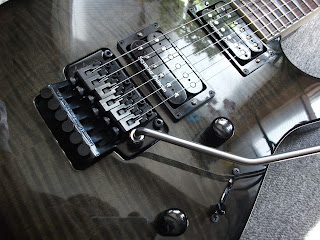This is a comparison/review of the Fender Mini Deluxe and the Epiphone EP-1.
Both these amps are rated at 1 watt of power. This means that they are appropriate for practice, but not for performance. As such, I will be reviewing them as practice amps - not judging them as compared to "real" amplifiers. That said, there are many plug-in style practice amps that do not come close to the quality and sound of these little beasts.
As you may know, I am currently living in Seoul, South Korea, and I brought these babies along with me from Canada so I wouldn't have to play acoustic guitar for a whole year - what a great decision!
First, the similarities: Both amps are 1 watt, solid state, single speaker amps. They are both quite portable, and feature a single input and a headphone jack. Both can be powered by either a 9v battery or a 9vDC adapter (a standard Boss pedal adapter does the trick). However, this is where the similarities end. Despite being designed for the very same purpose, these little guys are actually quite different in their features, their construction, and their sound.
First up, the Fender MD-20 Mini Deluxe. One of the neatest things about this portable tone machine is its appearance. It is essentially a miniaturized Deluxe Reverb (though obviously without the reverb). The casing is made from plastic, but the chassis is metal, and there is even a little handle on top!
The controls on this amp are pretty simple: Volume, Tone, and Drive, and all of them go up to 12! The clean sound is decent, but it is a little tinny, and if your guitar has bad pickups, the tone is almost intolerable. Conversely, if you have good pickups, especially humbuckers, the sound is totally tolerable. Where the Mini Deluxe really shines, though, is with the drive cranked all the way up, and the tone around 3 or 4.
Another cool thing you can do with this amp is use it as an overdrive pedal. Just plug your guitar into the amp, and run a patch cord out from the headphone jack into your amp (I actually saw
Jonny Greenwood of
Radiohead do this at a show back in 2007). Probably the best thing about this amp is its portability; it is pretty small (about 4"x6"x2.5") and weighs less than a pound.

Next up, we have the Epiphone EP-1, a solid, quality practice amp. It is about twice the size of the Fender Mini Deluxe, and much more ruggedly built. With its tweed-covered wood enclosure, and a larger 3" speaker, this amp has better acoustic qualities than its Fender counterpart. It is also much louder; again, most likely due to its larger size.
The controls are slightly different; there is a Volume and a Tone knob, and a 3-way switch to select between Off, On, and Drive (there are separate clean and overdriven channels) The clean sound is far superior to the Fender, but the drive channel leaves much to be desired. It is not very saturated distortion, and tends to sound a little like a chainsaw. However, if you put the amp on the drive channel and turn the drive down really low, it does fill out the sound quite a bit. The EP-1 is also more forgiving to low-quality pickups, and takes pedals much better than the Mini Deluxe.
The Verdict: Both amps are pretty nice, but which one is better really depends on what you want to use it for.
Fender Mini Deluxe Epiphone EP-1
Highs:
-Great lead tone -Great clean tone
-Super portable -Very solid construction
Lows:
-Tinny clean sound -Bad drive tone
-Plastic parts (jacks, casing) -No separate drive knob





























 what th
what th













